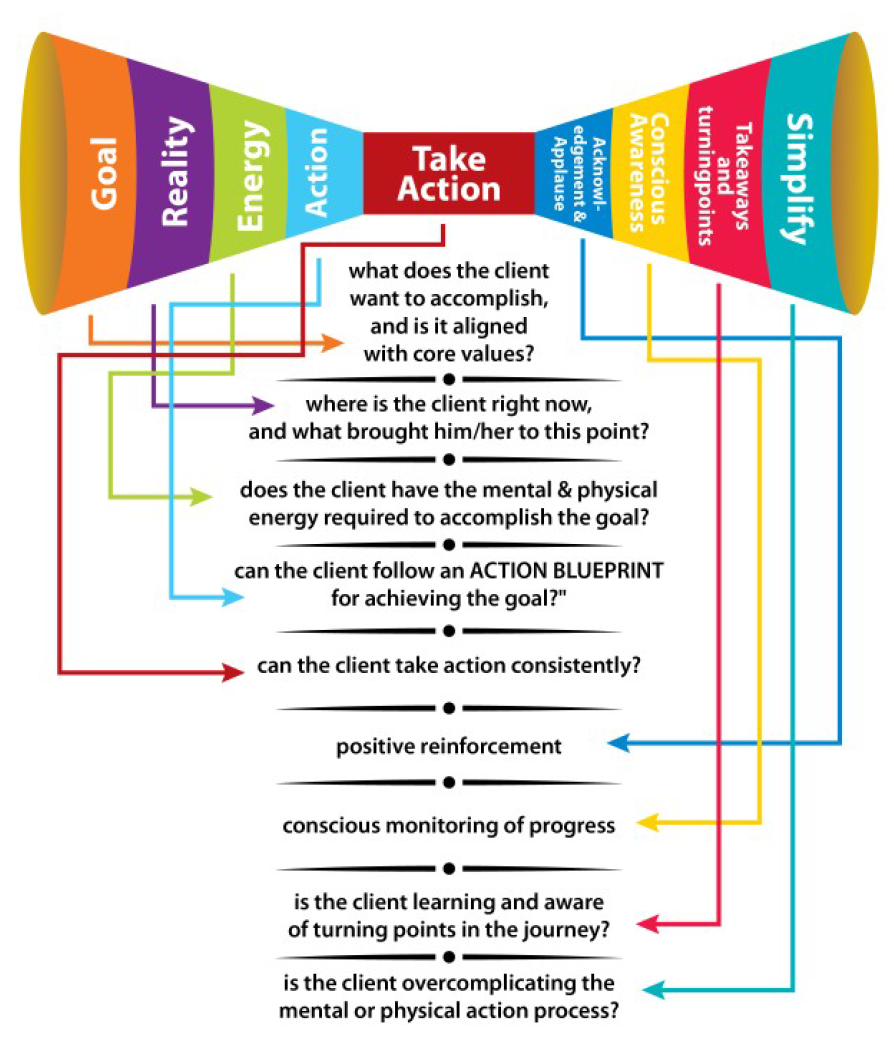A Coaching Model Created by Christy Calbos
(Small Business, Attorney, and Wellness Coaching, UNITED STATES)
 The process is defined with attention to each phase of planning, action, reinforcement, and reflection.
The process is defined with attention to each phase of planning, action, reinforcement, and reflection.
G.R.E.A.T. A.C.T.S.
G – Goal (what do you want to accomplish, and is it aligned with your core values?)
We begin by knowing precisely what we want to achieve. This gives us a focus to concentrate upon. We recognize and resolve guilt, inner conflict and limiting beliefs so that we do not sabotage ourselves. We ensure the goal is aligned with core values so that it has personal meaning and reflects your basic needs and your self-identity.
This ensures that it will be more likely that you stick with the goal over time. The key questions in this phase are:
R – Reality (where are you right now, and what brought you to this point?)
We assess the current reality and identify patterns, behaviors, habits that contributed to the current situation. We explore solutions so that we are prepared for the journey ahead.
E – Energy (do you the have requisite mental & physical energy required to accomplish the goal?)
We assess the circumstances that you are currently in. You engage with a level of mental (enthusiasm v. fatigue, boredom) and physical (good health v. struggling with illness) energy and monitor the amount that will be required. Adjustments are made accordingly.
A – Action (we create and monitor an ACTION BLUEPRINT for achieving the goal)
Coaches and clients, together, create an action blueprint which backward-chains the smaller steps that are needed in order to reach the goal by the deadline. Being very specific with the tasks for daily, weekly, monthly, and quarterly actions may seem tough at the outset, but is a learned skill and this process can be revisited again and again as you gain momentum and information in the “Take Action” step.
T – Take action (you must take action consistently)
Taking action is the entire point of coaching. Coaching without you taking action is not useful. Your action may include a period of discovery, learning, researching, discussing, identifying, learning and adding to your actions to take. Some people can get caught up in the ‘prepare’ stage, when in fact what they need is to move and motivate themselves further. We ensure that forward movement is on your mind & calendar.
A – Acknowledgement & Applause (positive reinforcement assists with motivation & momentum)
Positive reinforcement is a genuinely important part of goal achieving. Many of us set goals, achieve, and the continue to move forward without ever pausing to acknowledge the dozens of small steps taken along the way, let alone the end result. Selfacknowledgement and applause are happy rewards that serve as important motivational tools.
C – Consciousness (conscious monitoring of progress – are you taking action, monitoring energy, acknowledging yourself?)
Remaining aware of where we are in “space and time” is helpful particularly with midand long-range goals, which require perseverance and dedication. We ask ourselves weekly questions so that we are conscious of our progress, i.e., am I taking action (or just thinking about, getting ready to, or pretending to)? Am I mentally and physically primed for these action steps? Am I rewarding myself with acknowledgement (and accepting self-applause and applause from others)?
T – Takeaways and turning points (from one week to the next, are you learning what works & doesn’t, and are you aware of turning points in the journey?)
As we move through the coaching process, it is valuable to spend time reflecting upon the lessons learned, thoughts, habits, and actions that make up the moving parts of progress. We discuss the “takeaways” and “a-ha” moments, or turning points, where we feel an upward shift in the awareness of what we did exceptionally well, of obstacles, and of future improvements.
S – Simplify (are you overcomplicating the mental or physical action process? And: Return to “A”)
The tendency to make life difficult and complex is exacerbated with meaningful goals, laden with value and significance, are added to our full plates. We constantly examine ways to keep it simple, resist the tendency to overanalyze-and-paralyze, and simply “do the next, right thing.” In an ebb and flow, nonlinear way, the process of achieving GREAT ACTS is repeated with a return to “A” for action.